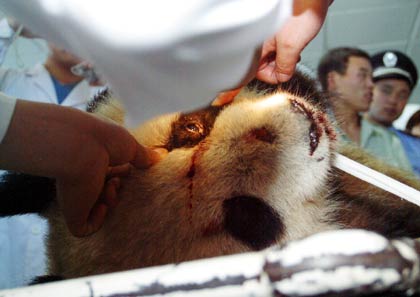Chinese veterinarians and dentists are considering
planting teeth for an injured wild giant panda in northwestern Shaanxi Province,
an expert said Wednesday.

Doctors at a hospital in Xi'an check a
bleeding eye of a wild giant panda, which was rescued from a forest park,
Northwest China's Shaanxi Province, July 1, 2006. A group of tourists
found the panda, which suffered serious injury and lost consciousness
under its waist, experts at the local wild animal help center said in
Xi'an. [Newsphoto] |
The operation is aimed to help the giant panda, who lost three teeth and
suffered fractured skull, broken legs and chest injuries after a fall into a
ravine, to take in more nutrition and thus restore physical strength.
With the three teeth, the giant panda will be able to regain normal chewing
function and thus can eat bamboo with ease, said Li Liujin, an expert from the
No. 4 Military Medical University, which is based in Xi'an, provincial capital
of Shaanxi.
The panda was found lying near a river by tourists on July 1 at a scenic spot
about 80 kilometers southwest of Xi'an.
Thanks to careful treatment, the panda is recovering. Its body temperature,
breath and pulse have returned normal, Li said.
It now can turn over by itself despite the swollen back legs, Li said.
"This is good news for us. Its physical and spiritual conditions are both
improving, better than our expectation. We believe it's out of danger for the
moment," Li said.
"Bamboo leaves and shoots are indispensable to giant pandas, so we are
planning to plant teeth for it after it began to show good appetite. We hope it
can become strong again soon with better nutrition absorption," Li told Xinhua.
At the hospital, the giant panda is now being fed with milk and a mixture of
bamboo leaves and wheat powder. It is also receiving nutrients intravenously.
Experts are also working on a plan of neural treatment for the injured bear,
Li said.
However, an operation needs at least 1,500 ml matching plasma, which is hard
to find from other pandas, experts said.
They are extracting blood plasma a bit at a time from the injured panda
itself. "We have already collected 200 ml, but it is far from enough," said Ma
Qingyi, a veterinarian with the provincial rare animal rescue center.
China launched a special project for the protection of giant pandas and their
natural habitats in the early 1990s. So far four centers or bases for panda
propagation have been set up, with encouraging results in panda protection.
To date, China has built 55 nature reserves, plus a dozen protective
corridors connecting the nature reserves, for giant pandas, with the area of
natural habitats for giant pandas enlarged from 1.4 million hectares in the
early 1990s to 2.3 million hectares.
The efforts have brought more than 70 percent of the giant panda species
living in the wild under effective protection, according to the State Forestry
Administration.
Over 180 giant pandas are now living in captivity, and about 1,590 live in
the wild, mostly in more than 40 nature reserves in Shaanxi, Sichuan and Gansu
provinces, the administration said.
Giant pandas, said to have been around when dinosaurs roamed the earth, are
cited as a "national treasure" of China.